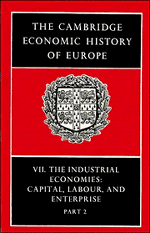CHAPTER V - Entrepreneurship, Ownership, and Management in Japan
from JAPAN
Published online by Cambridge University Press: 28 March 2008
Summary
Introduction
Because of its rapidity, sustained achievement, and initial low per capita income, the process of Japanese industrialization is a fascinating subject of study for economists and economic historians. An increasing number of Western students of Japan, after nearly two post-war decades of concerted work with their Japanese colleagues, are providing us with a substantial amount of quantitative evidence on the performance of the Japanese economy during the past hundred years. This evidence has been examined and re-examined, and we now have extremely useful sets of analyses and yet more refined data which compare favourably with those made for any other nation.
While these studies on Japan – analogous to those of Deane and Cole and others on England – were being made, another set of equally important questions for economic historians trying to understand Japan's industrialization suffered relative neglect. I refer to the set of questions which can be loosely classified under the heading of ‘entrepreneurship and management in historical perspective’. More specifically, this is the whole spectrum of questions relating to the rise, recruitment, and composition of entrepreneurship; ownership and control; and the management of industrial firms in the process of Japan's industrialization and modernization.
During the past several years, increasing attention has been paid to these questions by Japanese and Western students alike. But the literature on these aspects of Japanese economic history is either inaccessible or fragmentary, or both. The inaccessibility is mostly due to the fact that the literature is available only in Japanese.
- Type
- Chapter
- Information
- The Cambridge Economic History of Europe , pp. 215 - 264Publisher: Cambridge University PressPrint publication year: 1978
References
- 2
- Cited by



